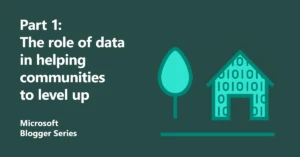
From Zero to Analytics with the Microsoft Cloud
Transforming the NHS
As John Newton writes in the foreword to the National Information Board’s Annual Report: “As recently as 2014, the NHS was declared the highest-ranking healthcare system in the world on quality, access and efficiency. Nevertheless, the size and scope of its services, […] seems to have hindered its ability to select and adopt some of the best digital technology […] A new, more holistic view of health and a recognition that services need to put the patient centre stage, also generate new requirements and opportunities for digital approaches.”
Microsoft are proud to work with the NHS and is committed to supporting the NHS’s digital aspirations of using data and technology to deliver the Sustainability Transformation Plans.
In the last few weeks we hosted a series of webinars to help your healthcare organisation start their sustainable transformations journeys to the Cloud in a simple way. They are hosted by Rob Orwin, our Technology Strategist, who designed the webinars to help you get from “Zero to Analytics” with the Microsoft Cloud.
Store Medical Imaging Files on the Cloud
We saw that many healthcare organisations are finding their current storage infrastructure is under increased pressure and nearing (or in some cases, exceeding) its on-premise capacity. Often, these are expensive Enterprise SAN storage solutions and the cost of expanding them can be in the tens or hundreds of thousands. Which is very daunting to both Finance and IT Departments!
Our first webinar was about storing medical imaging files on the Cloud, a very easy step to take that allows you to experience some of the benefits of the cloud relatively quickly:
- Medical imaging files are growing in size as the advancements in the imaging hardware and PACS systems lead to huge improvements in image fidelity and even bigger leaps in file size – it is not unusual to see a CT scan image file, several Gigabytes in size, for example.
- Shared drives are overflowing with miscellaneous documents and files and are not regularly cleaned-out or archived.
- Data archiving policies can mean that archive or “cold” documents and files continue to be stored in the same place as current live “hot” documents and files that are in regular use.
- Backup and Disaster recovery strategies and technology is not up to the job. Often copies of files are stored in the same place as originals.
Watch the webinar today:
Build a Hospital’s Data Centre
Traditional data centres can be a complex and costly. But where is the bulk of the money going? This might surprise you:
- 42% goes into hardware, software, disaster recovery arrangements, uninterrupted power supplies and networking. Costs are spread over time, amortised, because they are a combination of capital expenditures and regular payments.
- 58% into heating, air conditioning, property and sales taxes, and labour costs.
The reality of the traditional data centre is further complicated because most of the costs goes into maintaining existing (and sometimes ageing) applications and infrastructure. Some estimates show 80 percent of spending on maintenance
Learn how to easily build a Hospital Data Centre with the Microsoft Cloud:
Make sense of your Healthcare Data
The fun part really starts once you are up and running with the Cloud. There’s no shortage of data; yet most organisations struggle to mine their data for insights into lowering costs, improving outcomes and increasing patient satisfaction. What if you could amass from multiple sources, pick out trends and patterns, and use that information to:
- predict what might happen to an individual patient with certain warning signs
- recommend treatment options based on successful outcomes for similar patients
- determine operational best practices by comparing data from multiple facilities
Watch Rob explaining how to use Azure to make sense of your healthcare data:
Explore the advantages that cloud computing offers and the options for taking it forward, from a finance perspective.
Find out more and read the CIPFA report
If there is an IT project that your NHS organisation would like to get started, get in touch to learn about the latest updates and technologies.




